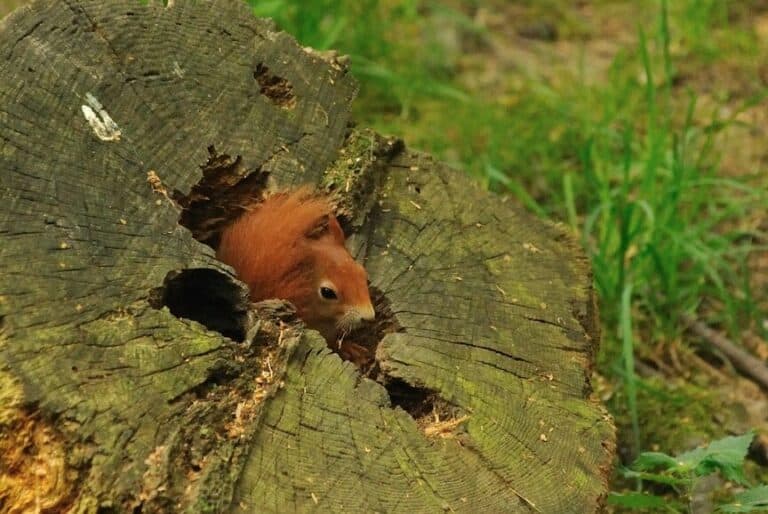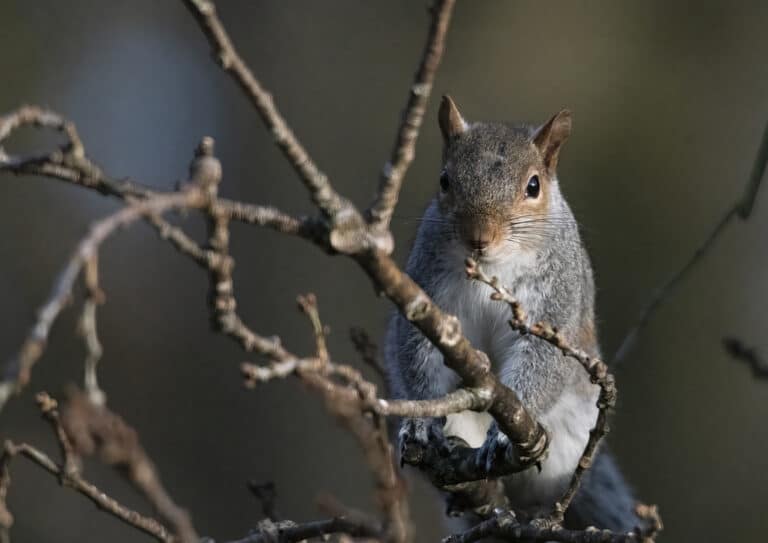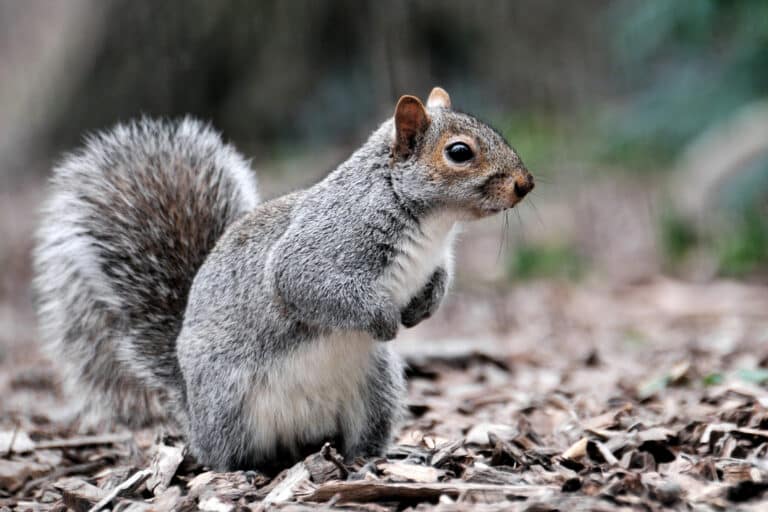Facts about Red and Grey Squirrels
Red Squirrel Scientific name: Sciurus vulgaris
Grey Squirrel Scientific name: Sciurus carolensis
At a glance
- Red Squirrels are native to the UK, Greys were introduced as ‘curiosities’ by wealthy landowners.
- Greys were first released here by a Victorian banker who grew bored of his new ‘pets’.
- In Scotland gamekeepers and foresters killed 102,900 Red Squirrels between 1903 and 1946.

Of the two squirrel species in the UK, the Red Squirrel, with its tufty ears, long bushy tail curled over its back, and bright, twinkling eyes, is – thanks perhaps largely to Beatrix Potter - instantly recognisable even though (unless they live in Scotland) many people will have never actually seen one.
That’s because Britain has just 160,000 or so Red Squirrels, and about 75% of them live in Scotland’s woodlands, parks and gardens.
Often common across a huge range that extends from the UK, Ireland and western Europe to Russia, Mongolia, and northwest China, Red Squirrels were once far more widespread here than they are now. Perhaps 3.5 million Reds lived in woodlands from the far north of Britain to the far south. So what has happened to them and why are they so scarce now?
The narrative that is repeated on website after website is that the decline of the Red Squirrel began with the arrival of the larger Grey Squirrel from North America. Greys didn’t get here by themselves of course, but were imported by collectors and wealthy landowners as curiosities. The first verifiable release into the wild was in 1876 when a Victorian banker, bored of his new ‘pets’, released a pair of Greys that he’d brought back from a business trip to America into Henbury Park, near Macclesfield in Cheshire. More releases followed. In fact releases of Greys into the countryside continued right up until the 1920s.
The Grey Squirrels brought with them the squirrelpox virus, which they were immune to but was fatal to Reds. Our much beloved native species began falling like dominoes, so the story goes, and conservationists have been fighting to save them ever since from the alien invader…
However, as so often when it comes to British wildlife, that’s not quite the full story.

Yes, Greys brought disease with them, but Red Squirrels were already declining as the woodlands they preferred – and Reds are quite specific about what they need – were being cut down, fragmented and converted. Deforestation in the 18th century led to local extinctions of Red Squirrels across the Highlands, and tree cover bottomed out at under 5% of Britain’s total land surface in 1919 after the First World War. Post-war advances in agriculture and urbanisation resulted in the felling of almost 50% (and in some areas of England and Wales even 100%) of the “ancient forests” Red Squirrels inhabited. Even where reforestation has taken place, studies in the early 2000s concluded that the three most commonly planted tree species are not suitable for Reds and that plantations of trees favourable for Red Squirrels had now matured, were being intensively felled, and were being replaced with less favourable but more profitable tree species.
And while we may all love Reds now, that has certainly not always been the case. Just as they were recovering somewhat from enormous habitat loss and being hit by the introduction as ‘curiosities’ of Greys, gamekeepers and foresters, who viewed Red Squirrels in their newly-planted woodlands as pests, were busy killing them in huge numbers. A bounty was offered for squirrel tails and between 1903 and 1946, 102,900 Red Squirrels were recorded as being killed In Scotland alone. The Highland Squirrel Club paid out £1,504 for Red Squirrel tails to members from up to 56 estates right up until 1946 (increasing the bounty from 4d to 6d as squirrels became more scarce). Records don’t include tails not submitted or the estates that did not belong to the group, so the actual figures killed are probably far higher. Right until the end of 1970s – when the majority of England and Wales held no populations numerous enough to be self-sustaining – Red Squirrels were still legally “pests”.

At the same time, estates and landowners across the UK were systematically removing the very predators that might have slowed down the progress of the Greys. Recent research has clearly suggested that Pine Martens might – in rural areas anyway as they don’t venture into urbanised landscapes – provide an effective defence against the spread of Greys. A 2014 study looking at the decline of Grey Squirrels in central Ireland suggested that “European pine marten abundance may be a critical factor in the American grey squirrel’s success or failure as an invasive species”. Red Squirrels of course co-evolved alongside martens and have better survival strategies than Greys – but of course animals like Pine Marten and Wildcats and raptors that might prey on the ‘unwanted’ Grey Squirrel were almost eradicated by the 1950s, often by the same shooting estates that killed so many Reds in the first place
Talking of ‘unwanted’ and ‘native vs non-native’ (the language used to describe Greys is invariably loaded: non-native, alien, vermin, tree-rats etc, and one recent Parliamentary debate even used class comparisons, saying Reds were like gentlefolk while Greys were rowdy invaders), the truth is that many of our surviving Reds are actually derived from reintroduced animals from Sweden – brought here, ironically, by shooters who enjoyed killing them and wanted to rebuild up populations where they’d already wiped them out. A DNA study in 2004 concluded that the vast majority of Red Squirrels currently living in the UK are descendants of squirrels recently introduced from Scandinavia – often long after the introduction of Grey Squirrels to the UK ended!
Many websites talk about the threats to Red Squirrels as if habitat loss, shooting, and ‘pest control’ had never taken place. It’s far easier to scapegoat an ‘alien’ species than ourselves, but there are another three factors that are impacting Red Squirrels today that are definitely human-based: road traffic accidents, predation by cats and dogs, and poor forestry practice.
A recent collation of studies to determine the main statistical causes of “unnatural deaths” of Red Squirrel in the UK found that 53% were killed on roads (mainly as they crossed to reach gardens with feeders (which it turns out may be concentrating and spreading the squirrel pox virus in the same way that avian pox spreads in the excreta left by birds at feeders) and another 14% were attributable to ‘predators’ which researchers identified as ’mainly’ cats and dogs.
We mentioned above that mature forests suitable for Reds are increasingly being felled. Remarkably, given the seriousness of the decline in the species, Red Squirrel dreys and even young squirrels are still dying during forestry practices.

In 2022 Charles Dutton, an independent woodland manager and director of the campaign group European Squirrel Initiative, estimated that between five and 10 per cent of the Red Squirrel population in Scotland is killed every year by commercial tree felling. He was responding at the time to an admittance by the Scottish Government’s forestry agency that “Red Squirrel nests may be “lost” when it cuts down trees”.
This is all the more frustrating given the level of legal protection given to Red Squirrels. They are now fully protected by Schedules 5 and 6 of the Wildlife & Countryside Act and should be safe at all times. They’ve certainly come a long way since the organised killings that so depleted them less than a hundred years ago. Grey Squirrels, conversely, have no protection, and since 2019 and the Invasive Alien Species Order can’t even be released into the wild after rehabbing at a wildlife hospital.
So what does the future hold for the Red Squirrel? Should we back an all-out war on one species to save another? There is no doubt that Grey Squirrels do harm and out compete Reds, but many animals are more successful than others. Where do we stop if we apply that logic. Removing Greys does help Reds, but a full-scale recovery will only happen if habitats are restored across the whole of the UK, we stop running them over, we stop our pets from killing them, and we stop cutting down trees while they’re nesting in them. And what does ‘full-scale’ mean anyway? Might we get to the point where they have recovered to such a point that – in much the way recovering populations of Common Buzzards are being looked at threateningly by shooting estates now – licences are requested to ‘control’ them again?
It’s a little trite to simply say that ‘Grey Squirrels didn’t ask to be brought here’ but it’s also true. It’s also true to say that a lot of people find Greys just as ‘cute’ as Reds, enjoy seeing them, and don’t want to harm them. Major decisions about the wildlife in our hugely changed and nature-depleted countries can’t simply be based on whether we ‘like’ one species more than another, or whether we ‘value’ one species more than another. Attitudes to animals – as the historical persecution of Reds demonstrates – change.
Perhaps the best that we can hope for is that any lethal control that does take place is done with the welfare of the targeted animal fully in mind, so not randomly shooting squirrels as they race through tree tops, and not using painful traps: painless sterilisation campaigns may perhaps be acceptable to some campaigners. And that any lethal control is not simply left open-ended. There must be an exit strategy, and an acceptance that it is irresponsible to even suggest that the Grey Squirrel can be totally eradicated from the UK..
